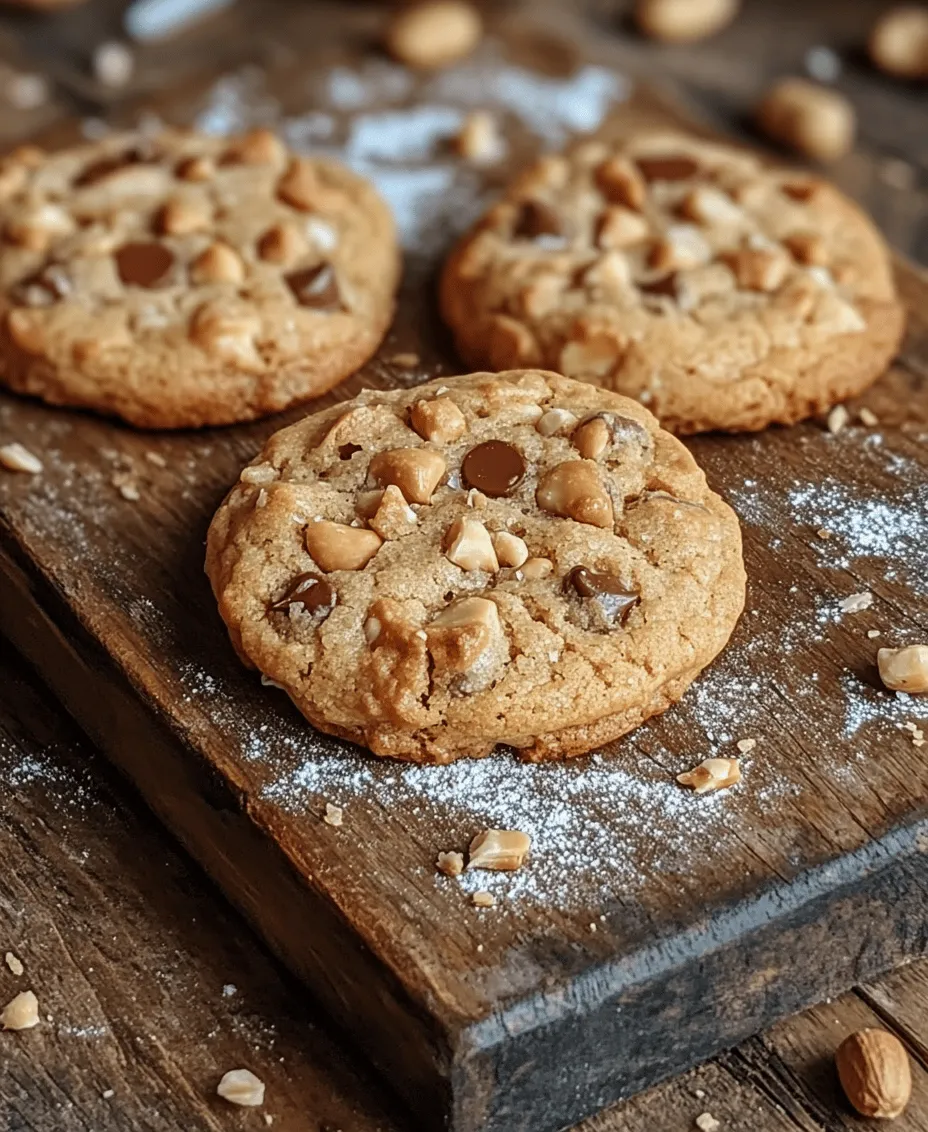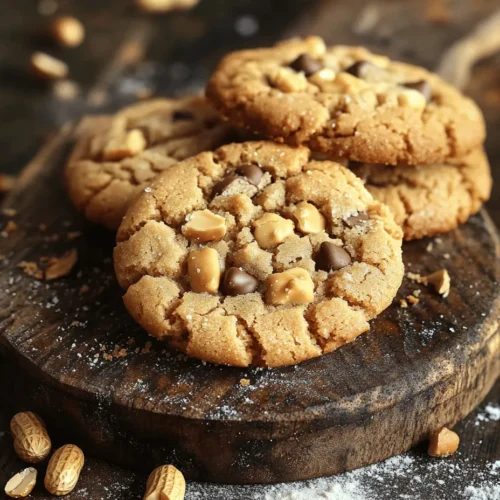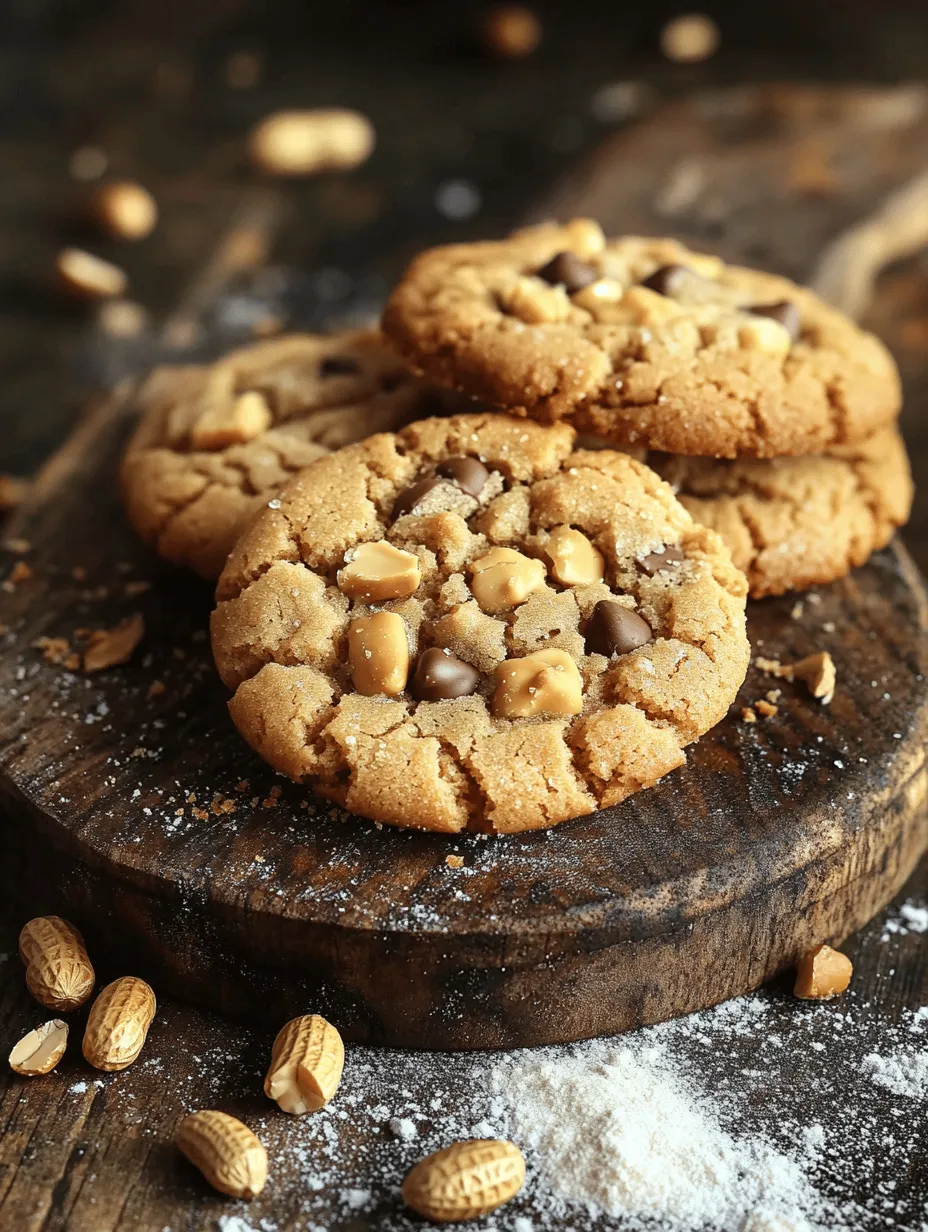Peanut butter cookies hold a special place in the hearts of many cookie lovers across the United States. Their rich, nutty flavor and soft, chewy texture create a delightful experience with every bite. Whether enjoyed as a snack, dessert, or a sweet treat during afternoon tea, these cookies are a staple in many households. The popularity of peanut butter cookies is rooted in their versatility; they can be dressed up with various mix-ins or left simple to highlight the peanut butter’s exquisite taste.
This recipe for thick and chewy peanut butter cookies promises to deliver that perfect bite—crispy edges with a soft, gooey center. The thick texture not only makes them satisfying to eat but also ensures they stay fresh longer. Plus, the addition of optional ingredients like chocolate chips, crushed peanuts, or even a sprinkle of sea salt can elevate the flavor profile, making each batch unique and personalized.
Understanding Peanut Butter Cookies
A Taste of Tradition in American Cuisine
Peanut butter cookies have a rich history within American cuisine, dating back to the early 1900s. The first known recipe for peanut butter cookies appeared in the 1890s, but they gained widespread popularity during the 1930s, largely due to the rise of peanut butter as a common kitchen staple. The introduction of commercially produced peanut butter, made accessible to families during the Great Depression, made it easier for home bakers to whip up these delightful treats.
Over the decades, the recipe has evolved, with variations that include different types of sugars, the incorporation of chocolate, or even the use of alternative flours for gluten-free options. The classic peanut butter cookie, however, remains cherished for its simplicity and the nostalgic connection many have to enjoying them fresh from the oven.
Why Are Peanut Butter Cookies So Popular?
The enduring appeal of peanut butter cookies can be attributed to several factors. First and foremost, they are incredibly easy to make. With just a handful of ingredients, even novice bakers can create a batch of cookies that will impress friends and family. The combination of sweet and salty flavors provides a satisfying contrast that keeps people coming back for more. Additionally, peanut butter cookies are incredibly versatile; they can be customized with various mix-ins, such as chocolate chips, butterscotch chips, or chopped nuts, allowing bakers to experiment and cater to different tastes.
Furthermore, the nostalgic element plays a significant role in their popularity. Many people associate peanut butter cookies with childhood memories, whether it was baking with a parent or enjoying them at school events. This emotional connection makes peanut butter cookies not just a treat, but a cherished part of many people’s culinary memories.
Ingredient Breakdown
To craft the perfect thick and chewy peanut butter cookies, it’s essential to understand the role of each ingredient used in the recipe. Here’s a detailed look at what goes into these delicious cookies:
Peanut Butter
Peanut butter is the star of this recipe, providing the signature flavor that defines these cookies. When selecting peanut butter, you can choose between smooth and crunchy varieties. Smooth peanut butter will yield a more uniform texture, while crunchy peanut butter adds delightful bits of peanuts that enhance the cookie’s chewiness and provide a satisfying crunch. Regardless of your choice, opt for a natural peanut butter that contains minimal additives for the best taste and texture.
Granulated and Brown Sugar
The combination of granulated and brown sugar is a key factor in achieving the ideal sweetness and moisture content in the cookies. Granulated sugar provides a crisp texture, while brown sugar adds a rich, caramel-like flavor and helps retain moisture, resulting in a chewy center. The balance of these sugars is crucial for creating that thick, indulgent cookie you crave.
Eggs
Eggs serve as a binding agent in the dough, helping to hold all the ingredients together while providing moisture. The proteins in eggs contribute to the structure of the cookies as they bake, ensuring they achieve the desired thickness and chewiness. For this recipe, one large egg is typically sufficient to achieve the right consistency.
Vanilla Extract
A splash of vanilla extract is essential for enhancing the overall flavor profile of your cookies. It adds warmth and depth, complementing the rich taste of peanut butter. Always choose pure vanilla extract for the best results, as artificial vanilla can impart a less desirable flavor.
Baking Soda
Baking soda acts as a leavening agent, helping the cookies rise slightly during baking. It creates air pockets that contribute to the cookie’s texture, making them light and chewy rather than dense. The small amount of baking soda in this recipe ensures that your cookies achieve the perfect lift without being overly fluffy.
Salt
While it may seem counterintuitive to add salt to a sweet recipe, salt plays a vital role in balancing flavors. It enhances the sweetness of the sugars and the richness of the peanut butter, ensuring a well-rounded taste. A pinch of salt can elevate your cookies from ordinary to extraordinary.
All-Purpose Flour
All-purpose flour is the backbone of the cookie dough, providing structure and consistency. The right amount of flour is essential for achieving a thick cookie that holds its shape while remaining soft and chewy in the center. Be sure to measure the flour accurately, as too much can lead to a dry cookie.
Optional Add-Ins
To take your peanut butter cookies to the next level, consider incorporating optional mix-ins such as chocolate chips, chopped peanuts, or toffee bits. Chocolate chips add a delightful richness that pairs beautifully with the nutty flavor of peanut butter, while chopped peanuts can enhance the crunch factor. These add-ins allow you to personalize your cookies and cater to different tastes.
Step-by-Step Instructions
Preheating the Oven
Before getting started with the dough, it’s crucial to preheat your oven to the appropriate temperature. For peanut butter cookies, preheating to 350°F (175°C) ensures that the cookies bake evenly and achieve that perfect golden-brown color. A properly preheated oven allows the cookies to rise properly, creating the thick, chewy texture we all love.
Mixing Wet Ingredients
Begin by creaming together the peanut butter, granulated sugar, and brown sugar in a large mixing bowl. Use an electric mixer or a sturdy wooden spoon to blend the ingredients until they are smooth and well combined. The goal is to achieve a creamy consistency, which will help incorporate air into the mixture, leading to a lighter cookie.
Once the sugars and peanut butter are well blended, add in the egg and vanilla extract. Mix until everything is fully incorporated. The mixture should be smooth and slightly fluffy, which is essential for achieving the desired texture in the finished cookies. If you’re using crunchy peanut butter, you may notice small pieces of peanut in the dough, which is perfectly fine and adds to the texture.
Now that your wet ingredients are ready, it’s time to incorporate the dry ingredients, which we will address in the next section. Remember, the key to thick and chewy cookies lies in the proper mixing and measuring of ingredients, setting the stage for a delightful baking experience.
Stay tuned as we delve deeper into the process and continue crafting these irresistible thick and chewy peanut butter cookies!

Incorporating Eggs: Importance of Mixing Technique
When it comes to thick and chewy peanut butter cookies, the way you incorporate the eggs into your dough plays a vital role in achieving the desired texture. Start by whisking your eggs in a separate bowl until they are well combined; this step ensures a uniform blend without any streaks. When you add the eggs to the peanut butter mixture, do so gradually. Mixing on a low speed allows you to incorporate air into the dough without overworking it, which helps to create a soft, chewy texture.
It’s essential to avoid overmixing once the eggs are added. Overmixing can lead to a tougher cookie due to the development of gluten. Aim for a smooth and creamy consistency, where the eggs are fully integrated but the mixture remains slightly thick. This careful technique will set the foundation for cookies that are soft in the center yet chewy around the edges.
Combining Dry Ingredients: Preventing Clumps for Better Texture
The next crucial step in your cookie-making process is to combine the dry ingredients properly. In a medium bowl, sift together flour, baking soda, and a pinch of salt. Sifting not only helps to aerate the flour but also eliminates any clumps, ensuring that the leavening agents are evenly distributed. An even distribution is key in achieving a uniform cookie texture, where each bite has the right balance of flavor and chewiness.
Once sifted, gradually add the dry ingredients to the wet mixture. Use a spatula or wooden spoon to gently fold them in. This technique prevents the formation of dry clumps and keeps the dough smooth. Be careful not to overmix; stop as soon as you see no visible flour. This will ensure your cookies maintain their thick and chewy qualities.
Folding in Mix-ins: Tips for Even Distribution
For those who wish to elevate their peanut butter cookies further, consider folding in mix-ins like chocolate chips, chopped nuts, or even a sprinkle of sea salt. To achieve even distribution, sprinkle your chosen mix-ins over the surface of the dough rather than dumping them all in at once. This method allows you to fold them in gently, ensuring that each cookie gets a delightful burst of flavor.
Use a spatula to carefully turn the dough over, folding it from the bottom up. This technique helps to maintain the dough’s structure while evenly distributing the mix-ins throughout. Remember, the goal is to keep the dough thick and not to overwork it, which could lead to a denser cookie.
Scooping Dough: Proper Spacing for Even Baking
Once your dough is ready, it’s time to scoop and shape your cookies. Using a cookie scoop or a tablespoon, portion out the dough onto a parchment-lined baking sheet. To achieve the perfect thickness and chewiness, avoid flattening the scoops. Instead, leave them in rounded mounds. This will help them maintain their shape and thickness during baking.
When placing the dough on the baking sheet, ensure there is adequate spacing between each scoop—about 2 inches apart. This spacing allows the cookies to spread evenly without merging into one another, resulting in uniformly baked cookies.
Baking Process: Monitoring Time for the Perfect Texture
Preheat your oven to 350°F (175°C) and place your baking sheets in the oven once it’s fully heated. The baking time for these thick and chewy peanut butter cookies is generally around 10 to 12 minutes. It’s important to monitor them closely, as every oven can vary slightly in temperature.
Look for the edges to turn golden brown while the centers still appear slightly underbaked. This is the perfect moment to remove them from the oven; they will continue to cook on the baking sheet from residual heat. Allow them to set for a couple of minutes before transferring them to a wire rack. This technique ensures the cookies maintain their delectable soft center while achieving the right amount of chewiness.
Cooling Cookies: Importance of Cooling on a Wire Rack
Once your cookies are out of the oven, the cooling process is just as crucial as the baking. Transferring the cookies to a wire rack allows air to circulate around them, preventing the bottoms from becoming soggy. This step is key to achieving the desired chewy texture.
Let the cookies cool for at least 10 minutes on the rack before indulging. This cooling period allows the cookies to firm up slightly, making them easier to handle while still retaining that irresistible soft center. Patience is a virtue here; the anticipation only enhances your eventual enjoyment.
Tips for the Perfect Thick and Chewy Texture
Balancing Ingredients for the Desired Consistency
To achieve that perfect thick and chewy texture, it’s essential to balance your ingredients correctly. Using the right ratio of peanut butter to flour is crucial; a higher peanut butter content generally leads to a chewier cookie. Additionally, consider using brown sugar in your recipe. Brown sugar contains molasses, which helps retain moisture and contributes to a softer texture compared to granulated sugar.
Adjusting Baking Time for Personal Texture Preferences
Baking time can also be adjusted based on your personal preference for cookie texture. If you prefer your cookies softer and chewier, remove them from the oven a minute or two earlier than the suggested baking time. They will continue to cook on the baking sheet even after you’ve taken them out of the oven. Conversely, if you enjoy a firmer cookie, let them bake a little longer until they are fully set.
Storing Cookies to Maintain Freshness and Chewiness
To ensure your cookies remain fresh and chewy, store them in an airtight container at room temperature. Placing a slice of bread in the container can help maintain moisture; the cookies will absorb the moisture from the bread, keeping them soft. For longer storage, consider freezing them. Place them in a freezer-safe bag and enjoy them later by thawing at room temperature or reheating briefly in the microwave.
Nutrition and Dietary Considerations
Nutritional Breakdown of the Cookies
These thick and chewy peanut butter cookies not only satisfy your sweet tooth but also provide a decent nutritional profile. A typical cookie contains approximately 150 calories, 8 grams of fat, 15 grams of carbohydrates, and about 3 grams of protein. Peanut butter is a significant contributor to these numbers, providing both healthy fats and protein, which can help keep you feeling full and satisfied.
Variations for Dietary Restrictions
If you have dietary restrictions, there are numerous ways to modify this recipe. For those seeking gluten-free options, substitute the all-purpose flour with a gluten-free flour blend. Make sure to check the blend’s compatibility with baking to ensure the cookies rise properly.
For vegan alternatives, replace the eggs with flaxseed eggs (1 tablespoon of ground flaxseed mixed with 2.5 tablespoons of water per egg). Additionally, use a vegan peanut butter and ensure that any mix-ins, like chocolate chips, are dairy-free.
Health Benefits of Peanut Butter
Peanut butter is not just delicious; it also boasts numerous health benefits. Rich in protein, healthy fats, and essential vitamins and minerals, peanut butter can be a beneficial part of a balanced diet. It provides energy and can help with muscle recovery, making it a favorite among athletes. Moreover, the healthy fats found in peanut butter can promote heart health when consumed in moderation.
Serving Suggestions
Creative Ways to Enjoy Peanut Butter Cookies
While thick and chewy peanut butter cookies are delightful on their own, there are several creative ways to enjoy them. Consider serving them warm with a dollop of whipped cream or a drizzle of chocolate sauce for an indulgent treat. Alternatively, you could sandwich two cookies with your favorite ice cream for a delicious ice cream sandwich that will impress guests.
Pairing Ideas with Milk, Coffee, or Ice Cream
These cookies pair beautifully with a glass of milk, which complements their rich peanut butter flavor. If you prefer a warm drink, a cup of coffee or hot cocoa can provide a cozy contrast to the sweetness of the cookies. For a dessert experience, serve them alongside a scoop of vanilla or chocolate ice cream, allowing the warmth of the cookies to slightly melt the ice cream for a delicious treat.
Presentation Ideas for Serving at Gatherings or Events
When serving these cookies at gatherings or events, presentation matters. Arrange them in a decorative cookie jar or on a tiered cake stand for an inviting display. Consider adding a small sign with the cookie name and a brief description of their deliciousness for guests to read. A sprinkle of sea salt on top can also enhance the visual appeal while adding an extra layer of flavor.
Conclusion
Making thick and chewy peanut butter cookies is a delightful experience that combines the joy of baking with the comfort of home. The process—from mixing the ingredients to the final bite—offers the chance to create something truly special. Not only are these cookies a treat, but they also allow for experimentation and personalization, making them a staple in many family kitchens.
Embrace the opportunity to make this recipe your own, adjusting ingredients and techniques to suit your taste preferences. Whether you bake them for a special occasion or simply to enjoy at home, these cookies are sure to bring smiles and satisfaction. Homemade cookies hold a comforting place in family traditions, evoking memories and creating new ones with every batch baked. So, gather your ingredients, follow these steps, and enjoy the delicious rewards of your efforts!


